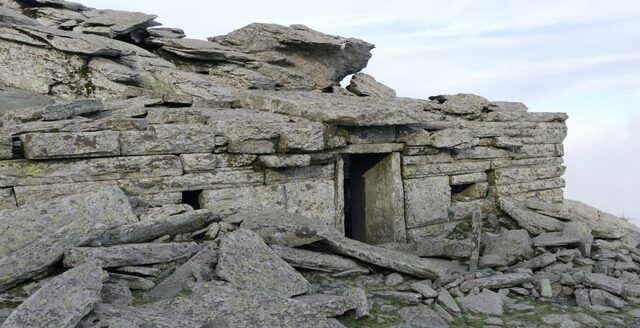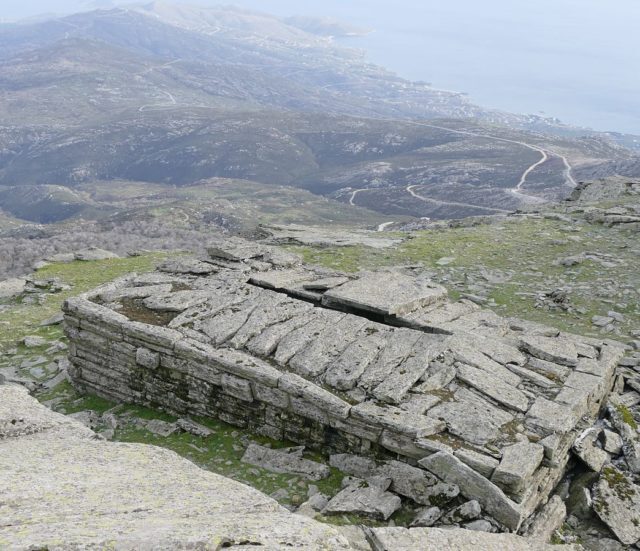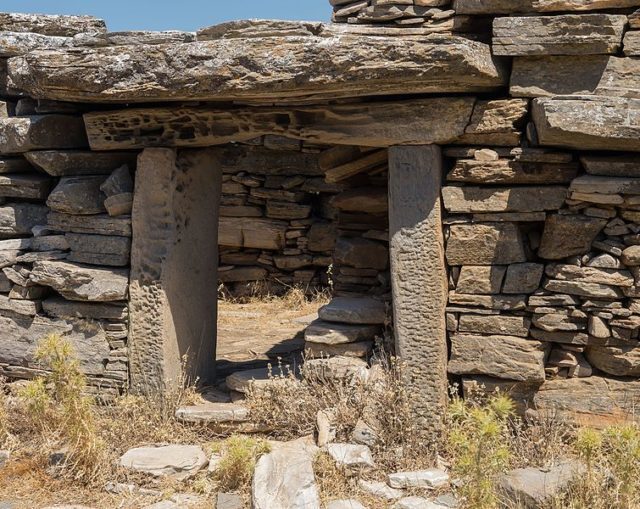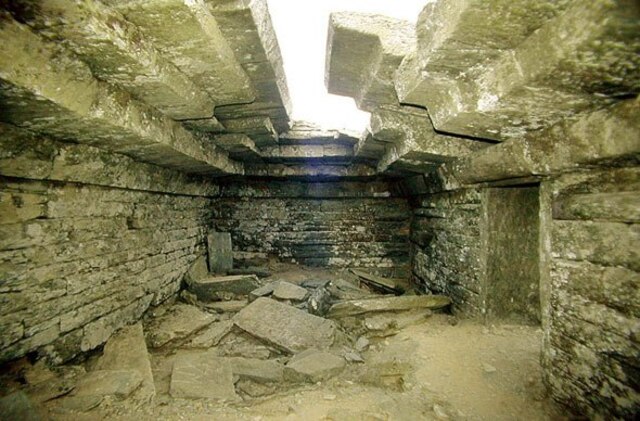Hidden high in the mountains of Euboea, Greece, lie a series of ancient structures that have baffled archaeologists for centuries. Known as the “dragon houses,” these megalithic buildings, dating back over 3,600 years, continue to spark curiosity due to their unique architecture and mysterious purpose. Despite their mythical name, the true function of these remarkable structures remains unsolved. As new discoveries shed light on their design and significance, the dragon houses stand as a testament to the ingenuity and mystery of ancient Greece.
Introduction: The Mystery of the Dragon Houses
The so-called “dragon houses” have intrigued scholars for centuries, particularly due to their unique architecture and strategic placement. These megalithic structures, located in the Ochi Mountain and Styra regions of Euboea, date back to the Preclassical period of ancient Greece, around 3,600 years ago. Despite their name, they bear no connection to dragons or mythology in the literal sense, but instead are admired for their striking design and construction. The mystery surrounding these buildings is further deepened by their enigmatic features, including their large, mortar-free stones and lack of clear historical records that explain their purpose.

The dragon houses’ extraordinary nature has captured the imaginations of both archaeologists and tourists, but even today, their exact function remains a subject of debate. Were they built as religious structures, military fortifications, or perhaps as observatories? Researchers have attempted to answer these questions, but the true purpose of these structures continues to elude understanding.
Video
Watch the video to explore the ancient Dragon Houses of Greece, a megalithic mystery that’s baffled archaeologists for centuries. Discover their secrets!
What Are the Dragon Houses?

The dragon houses are megalithic buildings made of large stones, often square or rectangular in shape, with some structures featuring massive monolithic blocks. The most remarkable aspect of their design is the absence of mortar, with the walls held together solely by the weight and precise placement of the stones. This method is similar to other ancient constructions such as the stepped pyramid of Djoser in Egypt and the pre-Columbian Teotihuacan temples in Mexico.
What sets these buildings apart, however, is the construction of their roofs. Large stone slabs are arranged in a pyramidal shape, forming a robust and durable cover that has withstood the test of time. This innovative roof structure is one of the key features that make the dragon houses stand out, as it suggests that the builders were highly skilled in engineering, using available materials in creative ways. Some of the most impressive examples can be found on Mount Ochi, where one of the dragon houses sits at an altitude of 1,386 meters, strategically positioned between the twin peaks of the mountain.
The Notable Drakospita on Mount Ochi
Mount Ochi is home to one of the most notable dragon houses, situated at an impressive altitude of 1,386 meters. This structure, located on a small plateau between the twin peaks of the mountain, provides a stunning view of the surrounding landscape. The position of the house is significant, as it appears to be carefully placed for long-range observation, a feature that has drawn the attention of archaeologists who suggest that the site may have had an astronomical or military purpose.
The construction of such a structure at such a high altitude raises questions about how the ancient builders transported massive stones to the site. Moving large blocks from lower elevations to the mountain top would have required advanced techniques, possibly involving ramps or pulleys, which speaks to the ingenuity of the builders and their understanding of engineering.
The Origins and Purpose of the Dragon Houses
Over the years, many theories have been proposed regarding the purpose of the dragon houses. One popular theory suggests that they were used as military fortifications, strategically placed to monitor the surrounding landscape for potential invaders. Their elevated positions and robust construction would have made them ideal for surveillance and defense.
Another theory posits that these structures may have served religious or astronomical functions. The Pantheon-like aperture in the roofs of the dragon houses is thought to have allowed sunlight or moonlight to illuminate the interiors, potentially serving as a means of marking important celestial events. The alignment of the structures with the azimuth of sunset and moonrise, particularly at Mount Ochi, has led researchers to speculate that these buildings may have been used to track the movement of celestial bodies, a common practice in ancient cultures.

Unraveling the Mysteries: How Were They Built?
The construction methods used to build the dragon houses are another intriguing aspect of the mystery. The sheer size and weight of the stones used to construct the walls and roofs of these buildings raise questions about how such massive blocks were transported and lifted into place. It is likely that the builders employed advanced techniques, such as leveraging tools and creating ramps, to move these stones to the high-altitude locations where the dragon houses are found.
The absence of mortar is another key feature that has puzzled archaeologists. The ability to construct such large structures without the use of mortar suggests that the builders had a deep understanding of engineering and the physical properties of stone. The precision with which the stones were cut and arranged reveals an advanced level of craftsmanship that was ahead of its time.
The Astronomical Connection: Alignment with Celestial Events
One of the most fascinating aspects of the dragon houses is their potential alignment with celestial events. Research has shown that the structures, particularly the ones on Mount Ochi, are aligned with the azimuth of sunset and moonrise. This alignment suggests that the builders may have had an understanding of astronomy and used the structures to observe important celestial phenomena.
The possibility of a Sirius-rise orientation, which dates back to around 1100 BC, adds weight to the theory that these buildings were used for astronomical purposes. The presence of apertures in the roofs of the dragon houses that allowed sunlight or moonlight to enter the interiors further supports this hypothesis, indicating that the structures may have been designed to mark significant moments in the solar or lunar cycles.
Archaeological Findings and Their Insights
Despite numerous archaeological excavations, including those by Professor Nikolaos K. Moutsopoulos in the 1960s and 1980s, conclusive answers about the dragon houses remain elusive. Artifacts uncovered at the site include pottery, animal bones, and inscriptions in an unknown script. Some of the inscriptions found on potsherds have deepened the mystery, as they are not immediately identifiable and could provide clues to the culture and language of the builders.
Although the artifacts uncovered offer valuable insights, they have not provided definitive answers about the purpose of the dragon houses. The mystery surrounding the true nature of these structures remains one of the most intriguing unsolved puzzles of ancient Greece.

The Role of Myths and Local Beliefs in Understanding the Dragon Houses
The name “dragon houses” evokes images of mythical creatures and supernatural forces, but it is likely that the term “dragon” also referred to individuals of great strength or power in ancient Greek tradition. This association with strength and power has led some to speculate that the dragon houses may have been linked to the ancient Greek gods or heroes, who were often depicted as possessing extraordinary abilities.
Local legends and traditions have long suggested that these structures were used as shelters, military fortifications, or even as temples for the gods. While these theories remain speculative, they add a layer of mystique to the already enigmatic dragon houses.
Conclusion: The Enduring Mystery of the Dragon Houses
The dragon houses of Euboea continue to be one of history’s most enduring mysteries. Despite the advances in archaeological research and the many theories proposed over the years, their true purpose and origins remain elusive. These ancient megalithic structures, with their extraordinary design and strategic placement, offer a tantalizing glimpse into the lives of the ancient Greeks and their sophisticated understanding of architecture, engineering, and astronomy.
As archaeological research continues, the dragon houses of Euboea remain a source of fascination and intrigue, keeping the enigma of ancient Greece alive for future generations. The more we uncover about these structures, the closer we get to understanding not only their purpose but also the incredible people who built them. Until then, the mystery of the dragon houses continues to captivate the imagination of all who encounter them.
Video
Check out the video to uncover the mystery of who built the Dragon Houses in Greece. This ancient enigma continues to spark intrigue among historians!



